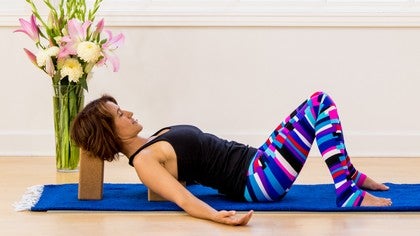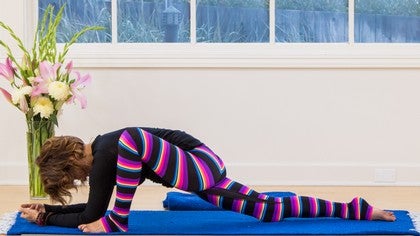Description
About This Video
Transcript
Read Full Transcript
(waves lapping gently) So, we get into big trouble if we think we know what compassion looks like. What can really help us be effective is to know what compassion feels like. Compassion is not empathy because while empathy might be a component of compassion, empathy can quickly turn a situation to be focused back on ourselves. So, in this sequence, what we'll do is we'll start out with a seated meditation with the hope of maybe touching a feeling of compassion that we can then take through the rest of our sequence because unless we can be compassionate in action, we can't really be much use. So, find your seat.
Snuggle in. Big deliberate inhale. Exhale everything. Let it happen and really soften down through the lower belly. Do that again.
Inhale. Exhale let it happen. Really, let the lower belly soften. Let your sit-bones and the Earth meet. If it makes sense, ease down through the floor of the pelvis.
Maybe even, like snuggle and wobble a little bit like a mother hen. Yeah, okay. Even let yourself slump a little bit so that you really allow yourself to feel this quality of grounded. Yeah, yeah, it should feel like the Earth has you, like you can really rest here. Only if this has been successful, so only as you have this real intimate sense of-- (purring) She's got me, then maybe start to let the back of the heart soften.
As you let the back of the heart soften, the shoulders will relax a little and without losing the grounding, letting the front of the heart feel more available. It's just the slightest brightness, just a gentle warmth. So, you're grounded, rooted, stable, supported and available, open wide. Elbows heavy. Find the alignment of the skull, so you finally notice her.
So, as the skull finds her proper alignment, there's this quality of expansiveness so you can get the clear information. Upper palate open. Eyes soft, maybe closed or just gently downwardly focused. This, these are the elements. Stable, grounded, rooted, safe.
Aware and open in the heart, tender. Clear and expansive in the mind. Now, if you're new to the practice of compassion or, in Sanskrit, karuna, maybe simply stay here. Just, oh. But, if you want to kind of test it a little bit, for the last few moments of our opening meditation, most likely, you have someone close to you who is suffering.
You probably already know who that person is. So gently, so tenderly, with your belly soft, you heart open and your mind clear, hands soft, let this person just kind of move into your field. Like, let this person who is suffering move into your field so tenderly, so gently. Can you remain grounded, open and clear? Couple more moments.
It's easy to get thrown off center. It's easy to try to want to help or to know what somebody might need. Can you, instead, listen? Last few beats. Listen, offer, ground.
Yes. Beautiful. Big deliberate inhale, exhale everything. Let this person be removed from your field. Again, inhale, exhale.
Nice. So, as we move into our practice, the play is like can we be in our ground? Can we allow our heart to be open? Can we let our mind be clear so that we can hear the next appropriate action without being thrown off center? Okay, really nice.
So, gently move the support out from underneath you and I'm gonna bring my blanket across my mat like so because I'm going to use it in our first shape, which is Puppy. Come onto your knees at the back of your mat. Let your hands come out in front of you. And, I'm putting my blanket in a spot so that my forehead is going to try to hit the back of the edge of the mat. Now, we're going to be in this for about two minutes so spread your fingers wide.
Wiggle on back through the hips. I'm wanting the blanket to be just be just underneath, like just below my elbows, my forehead to be just at the back of that mat. I'm lengthening and once I feel like I've found that support, relax through the back of the heart. So, there is compression happening in the back of the body. If you happen to be more of a spaghetti body, the support of the blanket underneath the forehead and the elbows will not be of use and you can ditch it.
Soft behind the heart, soft in the eyes. Can you remember that feeling of compassion? So, there's a grounded quality, there's an expansive quality. Yes. If you feel like your legs are having a hard time waiting, cross one ankle over the other.
Maybe switch the cross of the ankles. That's been about two minutes. Now, to get out of here, let your back start to round a little bit as you bring your weight forward, come onto your elbows. Let your head lift. Super-nice.
We're going to make our way to Child's Pose. Perhaps move the blanket out of the way unless you want to keep it there for extra padding for the lunge. Wobble your hips back, let your elbows bend. Forehead comes to the Earth. Super-nice.
Making our way to the lunge, let yourself come up onto all fours. I'm going to bring my left leg forward first. We're going to be in this lunge about two minutes, so inhale, draw your hips back a little bit like we do. Exhale, sink it in. Do that again.
Inhale, draw your hips back a little bit. Exhale, sink it in. Now, you've been doing this enough maybe by now that maybe you're choosing to keep your hands on either side of your foot, maybe you're coming in. Today, it feels good to me, and it usually doesn't, so I'm kind of surprised, but today It feels good to come down onto the elbows. Little bit of a happen.
And can you remember this quality of compassion? So, can you let it be heavy in the belly, wide in the heart, expansive in the mind? Yes, because how do we develop the capacity to be in the truth of the situation, accurately perceiving, letting the heart be open to what's in front of us, hear the clear instructions and be able to do something? Yes. Uh-huh. (exhaling) If you've gotten yourself into a situation in your posture that's deeper than is useful, that's causing strain and stress, then that's a clue, okay, that you might be better off backing out but these are place that we learn compassion.
These are easy situations. Okay, that's been about two minutes. We're going to make our way to Pigeon. Wobble the hips back a little bit. Toe, heel, left foot over.
Bring that foot as close to the hip as feels right for you. Sink into your Pigeon, or Swan, if you prefer that. We're gonna be here about two minutes. Wiggle it a bit. Okay, stay upright if that feels better.
Let your body ground. Wide in the heart, clear in the mind, so there's this quality of like Earth and Water in the lower belly. It's kind of a-- (purring) soil, like rich soil. There's this quality of like, spaciousness in the heart. Or more like, it's more like-- (exhaling) Yeah, spacious is a good word.
The mind is expansive. Yeah, again stay upright or let yourself start to lie on down on your elbows or your hands. Soften the belly, open in the heart. While it might be enough of a project to be practicing compassion right here on the mat with yourself, just really tuning to the exhale down to the lower belly, the softness of the heart and the openness of the mind, you could also start to invite your friend who is suffering into your practice. You could start to offer your awareness of your friend's suffering as a point of focus.
A few more moments here. We'll talk a little bit how to do that, but just see how you do that first because usually we know what to do. Okay, slow to get out of there. Hands come underneath the shoulders. Roll on up.
Find Child's Pose. Draw this left knee back to meet the right and wiggle on back. Okay, let's make our way to the other side. We're going to inhale breathe you up onto all fours. Bring your opposite foot forward, probably your right, and we're going to be here for about two minutes, so inhale, drop back a little bit.
Then, exhale, sink in, just like we've been doing. Inhale, drop back a little bit and then, exhale, sink it in. And again, this side is gonna be different so you might keep both hands on either side of that foot, you might have the hands come onto the inside of the foot. A little bit of a happen. Do be aware of the mind's tendency to want to make things match, so it might be tempting to do exactly the same thing on the other side.
Can you allow this side to reveal herself fresh? So, the play of bringing another into the practice is to actually just start to open your heart to them, so as you feel your grounding, your openness and your expansiveness, can you just let them be present with you as you inhale and you exhale? As you inhale and exhale. The temptation when people we love are suffering is to try to make it stop and with some honesty, we can start to acknowledge that oftentimes, we want their suffering to stop for our benefit more than theirs because the capacity for another's suffering is very difficult to develop. Soft in the lower belly.
Some of you may be down on your elbows. I did that on the other side but it's not appropriate on this side for me. Just about another half minute or so here. And it might be too much. If you start to bring this friend in and it starts to create anxiety and difficulty and struggle, then it's not time.
Just practice grounding, expansiveness, openness. Okay, nice. Slow, you're gonna draw your hips back a little bit. Make our way into Pigeon. This right heel's gonna come in close, this right knee forward.
Wiggle back through the back leg. We're offering ourselves here again for about two minutes. So, again, this quality of karuna compassion, grounded, open, expansive. Play with this. In the play, we're starting to breathe with another, to allow them to be present.
Okay, as the play, I'm starting to learn how to be in community as human beings, to practice accepting that sometimes it can feel like there is very little we can do. This is one of the most difficult points of acceptance. Kind in the eyes, soft in the upper palate. Easy, mm-hm. Again.
Main practice is just getting used to feeling grounded, open and awake, available. If there's the capacity, play with letting this friend of yours who is suffering and I highly recommend starting with somebody you love, somebody you care about. The advanced practice is holding the suffering of those that we have more difficult relationships with. Nice, last few moments. Beautiful.
Hands underneath the shoulders, chin into the chest. Roll on up. The suggestion is Child's Pose. Draw your hips back, knees come wide, big toes touch. Yes, yes.
Beautiful. Chin into the chest, come up onto all fours. Now, I'm going to suggest Saddle Pose as the shape, but that's not great for all of you so, by this time, you have a repertoire so if Saddle Pose isn't your thing, as your big toes touch and you come to sit on your heels and you come up, then you know, Seal or Sphinx or something like that. Okay, my knees are wide, I'm sitting on my heels. We're going to be here about three minutes, so if this is already uncomfortable, it's probably not going to work out because it's not going to get any better.
Once you feel settled in here, touch in with these qualities of compassion. Big deliberate inhale and exhale, ground. Brighten the heart, open the mind. Yes. As you're ready, hands are gonna come behind you.
Lift your hips up a little bit. Snuggle your hips down onto the heels. Right about here might be the spot and some of you might have home props and have a bolster up underneath that upper back. Otherwise, come on down to your elbows. It's okay if your knees come up off the floor.
You just let them get heavy again. Some of you, this might be the perfect spot. Compassion. Some of you, it might be easier to come a little bit lower. You let that upper back snuggle in.
There's an opportunity through the fronts of your thighs and she'll be reaching the tentacles of tension around the knees sometimes. Sometimes, it will feel a little warm, heated. Only you can know, though, if it's not all right. Your hands might rest on you or they might come overhead, letting the elbows bend. Soften the buttocks.
Grounded, open, and again, you might be in a project that's enough. You might not need any more projects here. But, if it's available, maybe let your friend come be with you and just be with your friend. Give room. Can we allow for the suffering, not as a complacent, not anything to do, but to allow for something invites the opportunity of understanding, invites the opportunity of information we didn't expect, invites the opportunity to be of assistance without demanding that things be other.
This is how we tenderize the human heart. This is how we start to align ourselves with the Buddhist observation that life is suffering. Now, we went in here without discussing how to get out of here. Sorry about that. So, there are a couple of options.
One option, which is actually a little more difficult than it sounds, is to gently roll to the side and free one leg and then the other. I often find it actually easier and safer to come back up by holding around my shins, okay? Use the elbows into the ground and start to help, let your abdominals help you up. Then, as you're ready, you use your hands to press back up. Now, pause.
To get out of here, I usually find it easier just to come forward and slide the legs back. Come down onto your belly. Pause on your belly for a moment and wiggle. Then, we're going to roll onto our backs. Oh, nice.
Hug your knees into your chest and wobble. Really nicely done. We'll finish our sequence with a little Half Happy Baby. Bend the knees, soles of the feet on the floor. As you're ready, let your right knee come into your chest.
You're welcome, if Happy Baby is asking more than is useful to your hips, you can simple work here with the knee into the chest. If Happy Baby's available, catch a hold of maybe the ankle or the outside of the outer right foot and let the right knee come in towards your underarm. Because it's kind of like the upside-down lunge, so you could stay here with this knee bent. If it's a little bit much in the back, bring the left knee into your chest. If it's appropriate for you to feel a little bit more, this left foot could come back onto the floor or even extend straight.
We'll be here about two minutes. Little bit of a-- (exhaling) It's not so easy to find the right amount of tension in this right hand, sometimes we can overdo it in this right arm as you pull down. So, can you allow that exhale to happen? To really let the hips sink, let the knee come in. Drop over to the side a little bit.
You could keep it coming straight down but ah, it kind of feels kind of good. Thunk, just kind of lean a bit to one side. Goodness, if there's one main advantage of practicing at home, of which there are many but, one of the main advantages of practicing at home is that you can kind of let it start to look however you want without worrying about getting in trouble. So, I've chosen to bend my left knee and I'm letting my right knee hit the ground as I tip a little over to the right and it feels great. If your arm or your hand is petering out, relax the grip more or back off on the knee into the chest.
Okay, so we're just going to release that. I like to let the knee come into the chest first and then release the right foot back down to the floor, knees bent, sole of the foot on the floor, left leg matches. Big deliberate inhale, exhale everything. Either keep the knees bent or let the legs draw straight. Sometimes, you just get this nice, cool whoosh down that right thigh.
Yeah, particularly through the front hip flexors. So, it's okay to feel sad. In fact, our capacity to feel the true sadness is a useful skill, which is different than being empathetic. Okay, bend the knees, both of your feet on the floor. Again, the empathy tends to mean we've made it about us.
Let the left knee come into the chest. Interlace around where the knee and the shin meet. If you prefer to work with the knee into the chest, if that's superior to Happy Baby, keep it here, okay? Only if it feels right, catch it on the outside of that left foot or maybe the ankle and let this left knee come down into this Half Happy Baby. We're going to be here about two minutes.
Some of you are going to find that drawing your right knee into your chest is superior. Generally, that's less strain in the back and you still get a nice groovy hip opener. It also allows you to be in Happy Baby without so much work in this left hand. Only if it feels good, right foot might come back down to the floor or maybe that right leg extends straight. So, you're back in the lunge that you were in earlier.
You're just supine. Little bit of a-- (exhaling) Then, again, maybe you want to tip over a little bit. I'm going to try that again on this side. Tip over a bit, that left knee comes down towards the Earth and you might even bend the right knee to help that. That can feel great.
Find out what feels good. Some of you might even play with letting the right knee fall open a little bit. Grounded down through the hips, open in the heart, clear in the mind and as we practice these different states, these internal states, the reason we practice them is so they are available more quickly when we really need them so we have them literally memorized, memorized by heart. Notice if you're working harder than you need to with the left hand, like soften the grip a little bit. Easier in the forearm and the bicep.
When you're ready to get out of there, maybe move back your knee into the chest. Let your left foot come back down to the floor. If and as you feel ready, let your legs go straight if it feels good. Sometimes you just get this nice, cool, like whoosh through the front of these hip flexors. It can feel awesome.
We're going to make our way toward Shavasana. Since I have this blanket, I'm going to bring it underneath my head, but it's not required. Arms come down along your side, shoulders roll back and down. Let your legs open. Big, deliberate inhale.
Exhale, let it out. Soft behind the heart, tender in the hands, kind in the eyes. If you've been working with a friend during this practice, inhale and exhale, thank your friend and let him or her be free of the situation. Let her or him leave your field. Let yourself remain with a tender quality in your heart.
Compassion is a verb. It implies action. It implies clear, grounded, correct action so as you're aware of your heart, be aware of your hands. Let them feel more receptive and offering because our hands are one of the primary ways we do our heart's action in the world. Let the Earth have a little bit more of you.
Let yourself feel more supported. Soften. You might choose to stay here longer but I encourage you to, when and if you're feeling ready, slow, slow, let the knees bend, soles of the feet on the floor. Let your right arm reach over the top of the head and slow roll onto your right side. Pause.
Then, allow your left hand to help press you back up. Find a seat. Hands find each other. Thank you for your practice today, dear yogi. Love.
Yin Yoga: Kira Sloane
Comments
You need to be a subscriber to post a comment.
Please Log In or Create an Account to start your free trial.























 , xok
, xok


